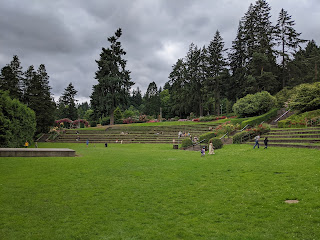After earlier seeing the two gripping memorials in Portland's Washington Park, Steven and I then made our way to the International Rose Test Garden, also located in the huge park. Portland, because it has long had a love affair with roses, was nicknamed the City of Roses. In 1888, Georgiana Burton Pittock invited her friends and neighbors to exhibit their roses in a tent set up in her garden. That was the start of the Portland Rose Society.
This Daily Travelogue is a labor of love for our families and friends at home and around the world. Prior to 2020, all our trips were documented on separate, yearly blogs which can be accessed below. Remember that clicking on any picture will open it for better viewing. Also, please consider adding your name at the end of any comments. Be safe, stay healthy, and stay connected.
Thursday, October 1, 2020
6/24: Portland, the City of Roses!
By 1905 Portland had 200 miles of rose-bordered streets which helped attract visitors to the Lewis and Clark Centennial celebration. In 1915, Jesse A. Currey, rose hobbyist and Sunday editor of the Oregon Journal, convinced city officials to institute a rose test garden to serve as a safe haven during World War I for roses grown in Europe because rose lovers feared that the unique plants might be destroyed in the bombings. After the idea was approved in 1917, hybridists from England began to send roses. Florence Holmes Gerke, Portland's landscape architect, became responsible in 1921 with designing the International Rose Test Garden and its amphitheater. The garden was dedicated in June 1924.
All we had to do was follow our noses to be bowled over by the heady fragrance of the more than 10,000 immaculately tended rose bushes! The riot of colors and perfumes were almost an assault on our senses but one I could willingly repeat often.
Thee surely were the biggest roses ever we'd seen!
When I saw this and other bags of rose petals that had been picked up by the many volunteers, I was reminded immediately of my deceased sister-in-law, Sydne, who used to loved to save rose petals from rose bouquets she'd received.
The bronze statue marked the 100-year birthday of the nonprofit Royal Rosarians, the official greeters and ambassadors of goodwill for Portland by mayoral proclamation.
We were so lucky being at the garden during the season of peak blooms as each rose bush was almost more beautiful than the last!
How Sydne would have loved these gardens!
These magnificent Dortmund roses regularly climb to a height of 8-10 feet as they lead from one level to another!
Not sure what you think but these two-toned roses were not my favorites.
How about some Ketchup and Mustard (roses) with your hamburger?!
Candy canes, anyone?!
Chipotle Restaurants should decorate their tables with these Chipotle roses!
Wild Blue Yonder roses:
I forgot to write down the name of this rose but it had the most exquisite rose scent that instantly reminded me of a rose perfume cream my mother used to dab on.
The rose arbors were, as you might imagine, just gorgeous!
Never had I seen the word Petiquette before!
How about enjoying a mug of hot cocoa with these Hot Cocoa roses?!
The International Rose Test Garden was so huge it even had a separate garden tucked away in honor of the great English writer, William Shakespeare! In 1945, the Shakespeare Garden was originally intended to include only herbs, trees, and flowers mentioned in Shakespeare's plays. Roses were subsequently named after characters in his plays.
We were drawn to the Shakespeare Memorial, a brick wall with a plaque featuring Shakespeare’s image and his quote, "Of all flowers methinks a rose is best." It was dedicated on April 23, 1946 - the 382nd anniversary of the bard's birth.
Steven and I have seen a huge number of gardens on our travels around the world but never one that listed so many flowers, let alone a single type, as here certainly.
This was a first, too, for us to see striped roses. They were quite, quite stunning.
Adjacent to the gardens was the Washington Park Amphitheater, which was designed to accommodate 5,000 people viewing a 300-square foot stage. Also known as both the Portland Rose Theater and the Rose Bowl Theater, it has become a popular public venue for concerts, theater performances, and other events.
In a secluded and isolated section of Washington Park was a fantastic artwork, Coming of the White Man, completed in 1904, that featured two Native Americans looking down upon the route that ox teams trudged bringing settlers to this part of the country. The older of the two is said to be Chief Multnomah of the Multnomah people.
I read on the Portland Public Art website that "Native peoples, conceived of as mysterious, dangerous and ignorant by white pioneers and their artists, were often depicted in artwork of the time as stunned, entranced, or thrilled by the invasion of covered wagons. Later, when what we now call genocide began to sink in to the white consciousness, images of Native people transformed to defeated warriors, beautiful squaws, vast landscapes overwhelming tiny teepees, and later again, with photography, severe portraits of alien and rough strangers."
Nearby was the statue erected by the women of the US in memory of Sacajawea, the only woman in the Lewis and Clark expedition, and in honor of the of the pioneer mother of old Oregon.
Next post: The National Sanctuary of Our Sorrowful Mother aka The Grotto later that afternoon.
Posted on October 1st, 2020, from "our happy place" at a state park on the Florida Panhandle. Steven and I hope that you and your loved ones say healthy, stay safe, and especially stay connected during these extraordinarily tough times.
Labels:
Oregon
Subscribe to:
Post Comments (Atom)















































No comments:
Post a Comment